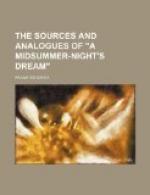“Whylom, as olde stories tellen
us,
Ther was a duke that highte[2] Theseus;
Of Athenes he was lord and governour,
And in his tyme swich a conquerour,
That gretter was ther noon under the sonne.
Ful many a riche contree hadde he wonne;
What with his wisdom and his chivalrye,
He conquered al the regne[3] of Femenye,
That whylom was y-cleped[4] Scithia;
And weddede the quene Ipolita,
And broghte hir hoom with him in his contree
With muchel glorie and greet solempnitee,
And eek hir yonge suster Emelye.
And thus with victorie and with melodye
Lete I this noble duke to Athenes ryde,
And al his hoost, in armes, him besyde.
And certes, if it nere[5]
to long to here,
I wolde han told yow fully the manere,
How wonnen was the regne of Femenye
By Theseus, and by his chivalrye;
And of the grete bataille for the nones
Betwixen Athenes and Amazones,
And how asseged[6] was Ipolita,
The faire hardy quene of Scithia ...”
Egeus, whom Shakespeare makes a courtier of Theseus and father to Hermia, is in the classical legend Aegeus, father of Theseus; both Plutarch and Chaucer so mention him.
The name of Philostrate also comes from Chaucer, where, as we shall see, it is the name adopted by Arcite when he returns to court in disguise, to become first “page of the chamber” to Emelye, and thereafter chief squire to Theseus. It is in this latter capacity that Chaucer’s “Philostrate” is nearest to Shakespeare’s character, the Master of the Revels.
Of the four lovers, the names of Lysander, Demetrius, and Helena, are of course classical; Shakespeare would find lives of Lysander and Demetrius in North’s Plutarch. The name of Hermia, who corresponds with Emilia or Emily of The Knightes Tale, as being the lady on whom the affections of the two young men are set, may have been taken from the legend of Aristotle and Hermia, referred to more than once by Greene. The name cannot be called classical, and appears to be a mistranslation of Hermias.[7]
The story of Palamon and Arcite has not been traced beyond Boccaccio, that fountain of romance, though he himself says the tale of “Palemone and Arcita” is “una antichissima storia.” Possibly the story was taken, as much of Boccaccio’s writing must have been taken, from tradition. Palaemon is a classical name,[8] and Arcite might be a corruption of Archytas. Boccaccio’s Teseide (the story of Theseus) which was written about 1344, and may have been first issued wholly or in part under the title of Amazonide, is a poem in the vernacular consisting of twelve books and ten thousand lines in ottava rima.[9]
Chaucer, in the Prologue to The Legend of Good Women (which is presumably earlier than the Canterbury Tales) states that he had already written
" ... al the love of Palamon and Arcyte
Of Thebes, thogh the story is knowen lyte.[10]”




